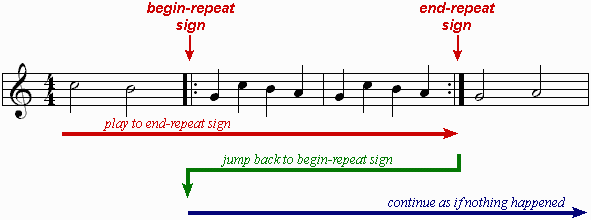
Repeats, Second Endings, and Codas
One of the most difficult things for beginners with no musical training
to grasp is the use of those things called repeats, second endings, and codas.
They appear in tab books everywhere but are never explained.
This page will do a quick overview of repeats, second endings, and codas, so you guys understand
exactly what these things mean. I hope this helps!
Repeats
Repeat signs mean the obvious: repeat what's inside them. They normally come in pairs,
and look like the image shown below:

If, when playing music, you come to an end-repeat sign, you jump back to the
begin-repeat sign and play on as if nothing happened. Unless otherwise noted,
only repeat something once. If there is no begin-repeat sign, go back
to the beginning and play from there.
Second Endings
Second endings are common in music. A second ending occurs when, for instance,
a verse is played twice; after the first time the chorus is played and after
the second time the bridge is played. The entire verse is the same except for the
last three or four measures, which are different. In this case, a second ending is
used. Second endings are notated as follows:
 |
 |
The first time through the verse, the first ending is played, then you follow the repeat sign back to the beginning of the verse and play it again. This time, however, you skip the first ending and jump to the second ending and continue on from there. This is shown below:
 |
 |
There can also be third and fourth endings, though they are rare. Simply do the same thing for a third or fourth ending as you would for a second ending.
Codas
A coda is an addition to the end of a piece of music. The notation for codas consists of the following two symbols, the "sign" and the "coda symbol:"

A coda is indicated by a phrase in the music stating either
A D.S. al coda means that you should go back to the sign and play from there until the coda symbol. At the coda symbol, jump to the end of the music and find the location of the coda (indicated again by the coda symbol). The D.S. stands for del signo, Italian for "from the sign to the coda."
A D.C. al coda means that you should go back to the beginning and play to the coda symbol, then jump to the coda. The D.C. stands for del capo, Italian for "from the top to the coda."
I hope this discussion has been helpful. It should clear up a lot of questions you have over things you've seen in tab books but have never understood. Good luck, and if you have questions please e-mail me!
Back to Dansm's Musical Notation for Guitar
You are visitor number
© 1997 Daniel E. Smith. Last updated 6-23-97